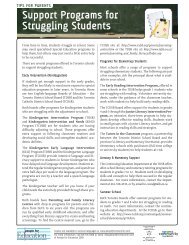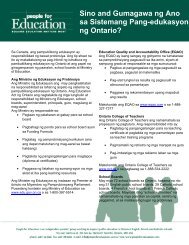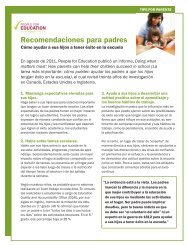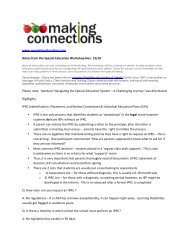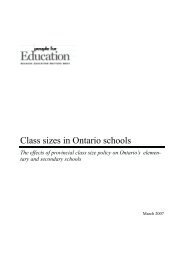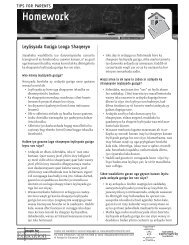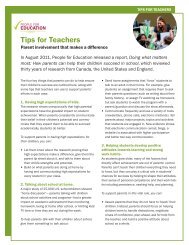Our Children Our Future Our Vision - People for Education
Our Children Our Future Our Vision - People for Education
Our Children Our Future Our Vision - People for Education
Create successful ePaper yourself
Turn your PDF publications into a flip-book with our unique Google optimized e-Paper software.
<strong>Our</strong> <strong>Children</strong>, <strong>Our</strong> <strong>Future</strong>, <strong>Our</strong> <strong>Vision</strong><br />
sciences and the humanities. Young students must feel that it is<br />
rewarding to pursue careers based on the traditional knowledge of<br />
their <strong>for</strong>ebears. 31<br />
Thus, the right to protect and promote traditional Indigenous knowledge systems is absolutely<br />
vital to the decolonization, healing, and future well-being of Indigenous individuals, families, communities<br />
and Nations, and should be central to any future legal or policy changes relating to First<br />
Nation education. The emphasis on local control over educational content, systems and outcomes<br />
is also critically important to the very knowledge system itself.<br />
Traditional Indigenous knowledges and languages must be a central feature of any First Nation<br />
education policy and funding <strong>for</strong>mula on a go <strong>for</strong>ward basis.<br />
Local control, exercised in a variety of ways (via First Nation community, Nation, treaty area, or<br />
region) is not only essential to the realization of educational outcomes but to the very content of<br />
the knowledges incorporated within those educational systems.<br />
(b) Treaty Right to <strong>Education</strong><br />
“not <strong>for</strong> to-day only but <strong>for</strong> to-morrow, not only <strong>for</strong> you but <strong>for</strong> your<br />
children born and unborn, and the promises we make will be carried<br />
out as long as the sun shines above and the water flows in the<br />
ocean” (Crown promises during treaty negotiations in 1880)<br />
This right of First Nations to educate current and future generations of First Nations peoples is<br />
part of the inherent right of self-determination which has been recognized not only in international<br />
declarations and conventions like UNDRIP, but also in domestic treaties between the Crown and<br />
Indigenous Nations. While not every treaty includes specific reference to education, the treaty<br />
relationship between the Crown and First Nations extends far beyond individual treaties. The<br />
Crown relied on the cooperation and support of Indigenous Nations to survive in our territories,<br />
to prosper from our trading networks, and to survive numerous military incursions from other<br />
European competitors and have thus already received their treaty benefit. 32 Whether promises<br />
were written, oral or understood through long-term policy decisions or actions, First Nations have<br />
a treaty right to education. It is time we were able to fully enjoy our treaty benefits.<br />
From early alliances to the Royal Proclamation of 1763, Kaswénta or the Two-Row wampum, the<br />
1764 Treaty at Niagara, and the specific individual treaties, the fundamental principles upon which<br />
the treaty relationship was based, like recognition of sovereignty, nationhood and title to lands,<br />
31 Indigenous Knowledge, supra note 2 at 14.<br />
32 RCAP, supra note 6. J. Borrows, “Wampum at Niagara: The Royal Proclamation, Canadian Legal History, and<br />
Self-Government” in M. Asch, ed., Aboriginal and Treaty Rights in Canada: Essays on Law, Equity, and respect <strong>for</strong><br />
Difference (Vancouver: UBC Press, 1997) 155 [Wampum at Niagara].<br />
Chiefs of Ontario<br />
8




